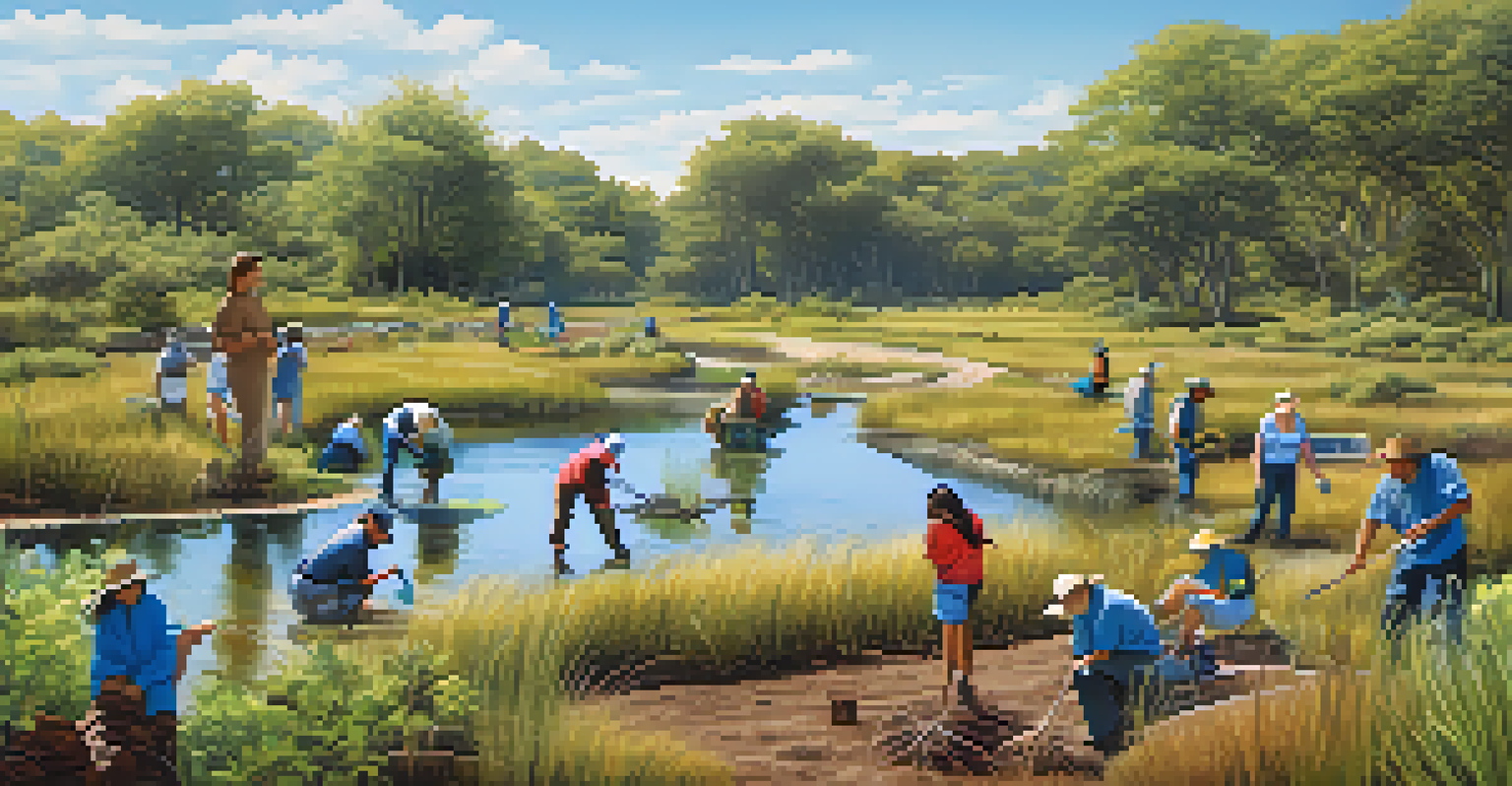Participatory Tourism: Engaging Travelers in Water Conservation

Understanding Participatory Tourism and Its Impact
Participatory tourism invites travelers to engage directly with local communities and environments. This approach not only enriches the travel experience but also empowers tourists to contribute to conservation efforts. By actively involving visitors in sustainable practices, destinations can promote awareness and responsibility toward natural resources, particularly water.
Traveling – it leaves you speechless, then turns you into a storyteller.
Imagine a traveler in a small coastal village, helping locals clean up a beach or restore a mangrove ecosystem. These activities foster a deeper connection between the traveler and the destination, making the experience more meaningful. As tourists witness the impact of their contributions, they become advocates for ongoing conservation efforts, both at home and while traveling.
Ultimately, participatory tourism encourages a mindset shift, where travelers see themselves as part of the solution rather than just spectators. This shift is particularly crucial in the context of water conservation, as it highlights the importance of sustainable practices in protecting precious water resources.
The Importance of Water Conservation in Tourism
Water is a vital resource for tourism, from the scenic beaches to the lush landscapes that attract visitors. However, the tourism industry can also contribute to water scarcity and pollution if not managed responsibly. As travelers flock to popular destinations, the demand for water can increase dramatically, straining local resources and ecosystems.

Take, for example, a resort that uses excessive water for its pools and landscaping. Local communities may suffer as a result, facing shortages that impact their daily lives. By raising awareness about these issues, participatory tourism can help travelers understand the delicate balance between enjoying natural beauty and preserving it for future generations.
Engaging Travelers in Conservation
Participatory tourism empowers travelers to actively contribute to local conservation efforts, fostering a deeper connection with the environment.
Encouraging tourists to participate in water conservation efforts—like beach cleanups or community irrigation projects—can mitigate some of these impacts. When tourists recognize their role in protecting the water resources that enhance their travel experience, they are more likely to adopt sustainable practices.
Engaging Travelers Through Local Experiences
One of the most effective ways to promote water conservation is by immersing travelers in local experiences. Activities such as farm stays, river clean-ups, or cultural workshops can educate tourists about the importance of water conservation in the community. These hands-on experiences allow visitors to see firsthand the challenges faced by local populations.
The journey not the arrival matters.
For instance, a traveler participating in a traditional fishing expedition can learn how overfishing affects local ecosystems and water quality. This engagement not only provides a unique experience but also fosters empathy and understanding. Tourists leave with a deeper appreciation for the environment and a commitment to sustainable practices.
Moreover, such local experiences can strengthen the bond between travelers and the community, creating a sense of shared responsibility for the environment. As visitors engage with locals, they become ambassadors for conservation, spreading the message of sustainability long after their trip ends.
Promoting Sustainable Practices Among Travelers
Incorporating sustainable practices into travel itineraries is crucial for promoting water conservation. Tour operators and destinations can highlight activities that minimize water usage, such as eco-friendly accommodations or tours that focus on conservation. By showcasing these options, travelers are more likely to choose sustainability over convenience.
For example, a tour that includes visits to water-efficient farms or conservation projects can inspire tourists to adopt similar practices in their own lives. When travelers see the real-world benefits of sustainable tourism, they are encouraged to make conscious choices that help preserve the environment.
Water Conservation is Crucial
The tourism industry must prioritize water conservation to mitigate its impact on local resources and ecosystems.
Additionally, providing educational resources—like brochures or workshops—can further empower travelers to engage in water conservation. By equipping tourists with knowledge and practical tips, they can become active participants in protecting water resources both during their trip and beyond.
Collaborating with Local Communities for Impact
Successful participatory tourism relies heavily on collaboration between tourists and local communities. Engaging residents in the planning and execution of tourism initiatives fosters a sense of ownership and responsibility toward local resources. This collaboration is essential for creating meaningful and sustainable tourism experiences.
Imagine a community-led project where locals and tourists work together to restore a damaged wetland. This partnership not only boosts the local economy but also strengthens community ties and enhances conservation efforts. When communities feel valued and empowered, they are more likely to prioritize the preservation of their natural resources.
Furthermore, by involving local voices in tourism decisions, stakeholders can ensure that conservation efforts align with the community's needs and values. This holistic approach can lead to more effective water conservation strategies and a more sustainable tourism model overall.
Harnessing Technology for Water Conservation Initiatives
In today's digital age, technology plays a pivotal role in promoting water conservation in tourism. From mobile apps that track water usage to social media campaigns that raise awareness, technology can amplify conservation messages and engage travelers. By utilizing these tools, destinations can reach a wider audience and encourage sustainable behaviors.
For instance, an app that encourages visitors to participate in local water conservation activities can create a sense of community among travelers. This interactive platform can provide real-time updates on conservation efforts and showcase the impact of their involvement. Such technology not only informs but also motivates travelers to take action.
Community Collaboration Matters
Successful tourism initiatives rely on collaboration between tourists and local communities, enhancing conservation efforts and local ownership.
Moreover, virtual reality experiences can immerse potential tourists in the beauty of water-rich ecosystems, highlighting the need for preservation. By making conservation relatable and engaging through technology, the tourism industry can inspire a new generation of eco-conscious travelers.
The Future of Participatory Tourism and Water Conservation
As the tourism industry continues to evolve, the importance of participatory tourism and water conservation will only grow. With increasing awareness of environmental issues, travelers are seeking more meaningful and responsible travel experiences. This shift presents a unique opportunity for destinations to embrace participatory tourism as a path toward sustainable practices.
By fostering deeper connections between travelers and local communities, participatory tourism can drive positive change in conservation efforts. As more tourists seek out experiences that prioritize sustainability, the industry must adapt to meet these expectations, promoting initiatives that protect water resources.

Looking ahead, the collaboration between travelers, local communities, and the tourism sector will be key to ensuring a sustainable future. Together, they can create a collective impact that not only enhances the travel experience but also safeguards precious water resources for generations to come.